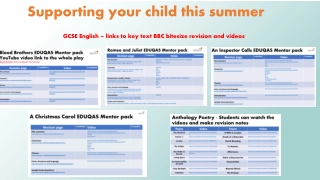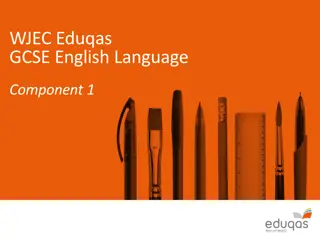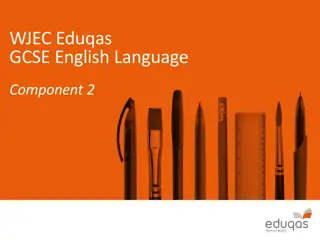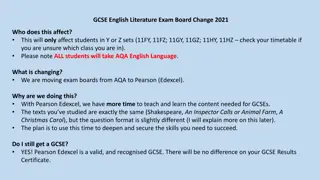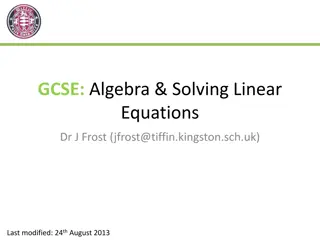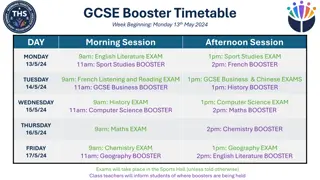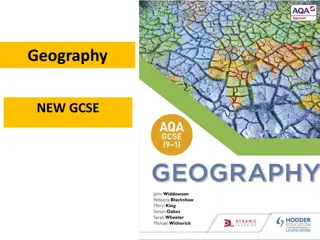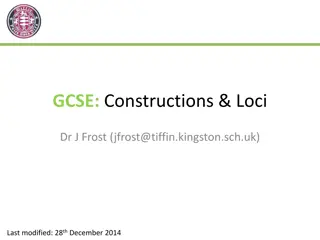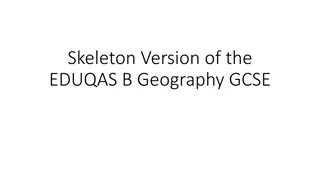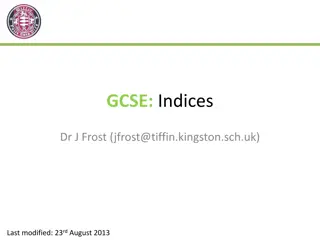
Assessment Criteria and Rubric Infringements in WJEC Eduqas GCSE Design and Technology
Learn about assessing evidence and understanding assessment criteria in WJEC Eduqas GCSE Design and Technology. Explore objective marking, academic judgement levels, and dealing with rubric infringements to enhance your evaluation skills.
Download Presentation

Please find below an Image/Link to download the presentation.
The content on the website is provided AS IS for your information and personal use only. It may not be sold, licensed, or shared on other websites without obtaining consent from the author. If you encounter any issues during the download, it is possible that the publisher has removed the file from their server.
You are allowed to download the files provided on this website for personal or commercial use, subject to the condition that they are used lawfully. All files are the property of their respective owners.
The content on the website is provided AS IS for your information and personal use only. It may not be sold, licensed, or shared on other websites without obtaining consent from the author.
E N D
Presentation Transcript
Assessing WJEC Eduqas GCSE Design and Technology
Assessing evidence Understanding the assessment criteria Assessment criteria generally take two forms: objective marking generally for low tariff responses, where knowledge of objective information is being assessed the exercising of academic judgement via: an assessment grid setting out criteria for different levels of response indicative content, that is, an indication of the kind of content responses may include.
Assessing evidence Understanding the assessment criteria objective marking For questions assessing objective knowledge, the assessment criteria should be applied precisely. Marks should be awarded as indicated and no further subdivision made. Where the assessment criteria list points which may be included in students' answers, the list is not exhaustive and teachers should credit valid alternative responses which are not listed. In general, credit should be given according to the accuracy and relevance of students answers.
Assessing evidence Understanding the assessment criteria exercising academic judgement through levels of response mark schemes Firstly, identify the appropriate band a student s response falls into according to the criteria. Award a band where the student s response covers the majority of the criteria. Secondly, consider a mark in the centre of the band and then increase or decrease the mark depending on the quality of the answer, which may be reflected in the amount of indicative content covered. If a response falls between two bands, consider whether there are more characteristics of the higher or lower of the two bands and award accordingly. Indicative content is not exhaustive and other valid responses may be credited.
Assessing evidence Rubric infringements WJEC Eduqas has a consistent way of addressing rubric infringements. Below is a list of the possible infringements which sometimes occur for this qualification Type of infringement Answering more than the stipulated number of questions Action Mark all optional questions that the student has attempted. Determine which of the attempted routes through the rubric elicits the highest mark. Award highest mark. Mark all responses offered by the student. Total the number of marks Deduct one mark for every additional response circled over the number stipulated in the question. Ticking/indicating more than the stipulated number of answers (MCQs)
Assessing evidence Rubric infringements Type of infringement Answering with the wrong symbol, e.g. ticking instead of crossing, adding a word instead of the symbol provided Action Mark wrong symbol as though it were the correct symbol if it is used consistently throughout the question. If the student puts a mixture of symbols, and the intention is clear, award marks accordingly. If the intention is ambiguous, mark only the correct symbol, as per the question. If a word (from the choices provided with letters) is used instead of the letter, mark as for the letter associated with the word Where the correct answer has been clearly crossed out. If the student writes and then crosses out the correct answer, do not award the mark, even if no other answer is offered.
Assessing evidence Rubric infringements Type of infringement Action Where the question requires a set number of responses and the student has provided more (open ended knowledge and understanding questions) Mark all responses offered. Total the correct responses and award marks up to the maximum mark Type of infringement Action Writing answers in the wrong place (constrained papers) If it is obvious to which question the response relates, award marks as per the marking scheme
Assessing evidence Assessment Purpose The subject content is presented under two headings: technical principles (2.1 pages 8-31 ) and designing and making principles (2.2 pages 32-34 of the specification). Within each area, the content is further divided into core knowledge and understanding and in-depth knowledge and understanding. Technical Principles Core knowledge & understanding In-depth knowledge & understanding a. Electronic systems, programmable components & mechanical devices Design and technology and our world Smart materials Electronic systems and programmable components Mechanical components and devices Materials Plus at least one from b. Papers and boards c. Natural and manufactured timber d. Ferrous and non-ferrous metals e. Thermosetting & thermoforming plastics f. Fibres and textiles Designing and making principles Core knowledge & understanding In-depth knowledge & understanding (in relation to at least one of a to f above)
Assessing evidence AO3 - Analyse and evaluate: Wider issues in design and technology AO4 demonstrate and apply knowledge and understanding of: Technical principles Designing and making principles Technical Principles Core knowledge & understanding Design and technology and our world Smart materials Assessment Resources Electronic systems and programmable components Sets 1-3: Core knowledge and understanding I Mechanical components and devices Materials Sets 4-6: Core knowledge and understanding II Designing and making principles Core knowledge & understanding Pages 8 14 (core knowledge) and pages 32 34 (designing & making principles) of specification
Assessing evidence AO3 - Analyse and evaluate: Wider issues in design and technology AO4 demonstrate and apply knowledge and understanding of: Technical principles Designing and making principles Technical Principles In-depth knowledge & understanding a. Electronic systems, programmable components & mechanical devices (pages 15- 17 of specification) b. Papers and boards (pages 18-20) Assessment Resources c. Natural and manufactured timber (pages 21-22) Sets 7-9: In-depth knowledge and understanding d. Ferrous and non-ferrous metals (pages 23-25) e. Thermosetting & thermoforming plastics (pages 26-28 Known as Question 6 f. Fibres and textiles (pages 29-31) Designing and making principles In-depth knowledge & understanding (in relation to at least one of a to f above)
Assessing evidence Characteristics of a successful response Successful responses rely on candidates reading the stem of the question carefully and understanding the requirements of each command word. Exemplar papers with annotated comments are available to help with understanding these command words. The following table may be a useful teaching tool: Command word Explanation State/Identify/Name A one word answer or a brief fact Describe Provide factual information or a short account Explain Detail required by giving reason(s) for why Discuss Key facts are expanded upon by providing reasons for and against Analyse Ensuring subject matter written is detailed but relates only to the issue provided by in the question Assess Weighing up the arguments for an against the topic being questioned on Evaluate Weighing up the arguments for an against the topic being questioned on. Often will refer to the advantages and disadvantages
Assessing evidence Assessment Criteria Question 6 (c) and (d) are marked based on Band Descriptors. The command words, justify, evaluate and assess are commonly used and require candidates to produce an extended piece of continuous writing. Mark scheme content is not prescriptive and candidates are not expected to refer to all the answers provided. An example from the 2019 paper follows: A t-shirt was made in a factory that uses the manufacturing system of cell production. Evaluate how cell production benefits the workforce. AO3 2b 6 marks A judgement is based on being able to weigh up points for and against. A coherent answer demonstrating detailed, relevant knowledge and understanding, to evaluate how cell production benefits the workforce. There will be evidence of relevant examples and well-developed substantiated judgements in a response which is logically structured. BAND 3 5-6 Answer has some coherence, demonstrating partial knowledge and understanding, to evaluate how cell production benefits the workforce. There will be some evidence of mostly relevant examples and partly-substantiated judgements in a response which is generally well structured. Band 3 candidates will be able to write succinctly always referencing the issue/topic in the question BAND 2 3-4 Answer demonstrates only basic knowledge and understanding, to evaluate how cell production benefits the workforce. There will be limited evidence of relevant examples or judgements in a response which demonstrates little structure. BAND 1 1-2 Award 0 marks for incorrect or irrelevant answers
Assessing evidence Characteristics of a successful response Evidence of correct working methods where mathematics questions are included Evidence that calculations have been practiced Candidates are familiar with a wide range of products, and the properties of materials that they are made from Answers are supported by explanation of why and further detail is offered to justify response, including examples Extended questions answers include judgements based on weighing up arguments for and against Answers reflect the marks available
Assessing evidence Characteristics of a less successful response Candidates did not carefully read the stem of the questions A lack of core knowledge of the range of commonly used materials Vague responses lacking real knowledge of the materials chosen Simplistic responses lacking detail or explanation There will be no judgements made in extended answer questions Marks available are not taken account within responses provided
Any Questions? If you have any questions, contact our specialist subject officers and administrative support team for your subject with any queries. designandtechnology@eduqas.co.uk

